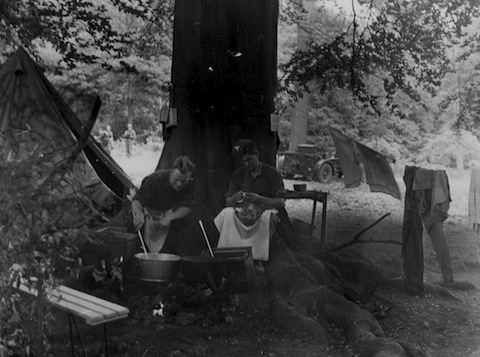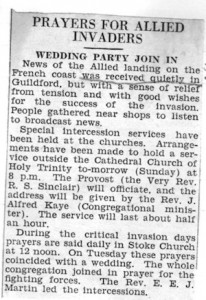 Abraham Lincoln
If given the truth, the people can be depended upon to meet any national crisis...
Abraham Lincoln
If given the truth, the people can be depended upon to meet any national crisis...
 Guildford news...
for Guildford people, brought to you by Guildford reporters - Guildford's own news service
Guildford news...
for Guildford people, brought to you by Guildford reporters - Guildford's own news service
What It Was Like Here As Troops Left For The D-Day Landings
Published on: 5 Jun, 2014
Updated on: 6 Jun, 2014
By David Rose
Seventy years ago today (June 6) saw a significant turning point in the Second World War.
It was D-Day and the Allies landed a huge armed force on the Normandy coast of northern France – the start of the campaign to push back the Germans from the countries they had occupied.
News of the opening up of what was called the Second Front was soon being reported.
June 6, 1944, was a Tuesday, and by the time Guildford’s local newspapers were published on the Friday (June 9), their observation of the dramatic events were that “people received the news quietly and calmly and went about their normal occupations.”
There was, according to the reports in Guildford, “an absence of excitement”.
Across Britain, the news of the D-Day landings broke at about 10am on the morning of the 6th. However, whatever the local press observed of the public’s reactions, many who witnessed it were taken aback by the scale of the massive build up of military activity in the Surrey area that had been going on for the past few weeks, if not months.
Many had seen scores of military vehicles rumbling through Surrey lanes, some being parked up and camouflaged.
In the Surrey Hills and around Albury and Shere for example, were camped lots of troops – many Canadians and some Americans.
Just before D-Day, General Montgomery, the senior British military commander on D-Day, visited Albury Heath and addressed Canadian troops camped in that area.
His message to the troops at that time was: “Good luck to each one of you, and good hunting on the main land of Europe.”
At the time people in and around Albury heard a rumour that an important military person was coming to visit the troops, so they lined the road across the heath to watch the spectacle.
Today, there is a cairn and plaque at the edge of Albury’s cricket pitch, erected by the Albury Trust, that commemorates Monty’s visit there in June 1944.
In the heavily wooded parts of the Surrey Hills in which the military occupied there were also ammunition dumps.
Young boys from the area and as far away as Woking would cycle into the woods and try to meet up and chat to the soldiers. They were usually allowed to enter the camps and could see the many piles of rifles and ammunition loosely covered by corrugated iron.
And then suddenly the troops with their equipment and their lorries and other military vehicles were gone. People living near roadsides heard the rumble of those vehicles, often in the dead of night, but knew not where they were going.
On the eve of D-Day the skies over Surrey began to fill with aircraft, some towing gliders, heading eastwards. It was then that many realised the Allied invasion had started.
My mother was employed at vehicle makers Dennis Bros on war work at the time. Because the weather was warm, she sometimes slept in a deck chair in the garden of her home in Baden Road, Stoughton. She later recalled that the excitement of seeing so many aircraft overhead kept her awake!
In its edition following D-Day, the leader column the Surrey Times noted: “The much-vaunted Atlantic wall of Hitler has been pierced, beachheads of a substantial character have been established, and the Navy and Air Force have accomplished prodigious feats of arms and organisation to enable the Army to to face once more the might of Rommel, and we trust that General Montgomery will again prove his master.”
The newspaper also reported that sales of national newspapers in Guildford “was unprecedented”, and “crowds surrounded newsboys in North Street”, while in the High Street “.. the scene was more orderly as people formed up in long queues. Supplies were quickly exhausted and strangers shared copies in the hope of gleaning latest informtion.”
That military build up that took place in the Guildford area and across the South East was not all plain sailing. The Surrey Times of June 9, 1944, reported that on the previous Saturday there had been a blaze at a nearby railway station (name not published for security reasons) in which an ammunition wagon caught alight. It was actually at Gomshall.
The report stated: “Smart work by Company Officer W. Reading of Guildford and personnel of No. 32 Fire Force in dealing with a blazing ammunition train averted a development which might have had serious consequences.”
The driver of the train saw that two of the 45 trucks that his engine was pulling were on fire when about half a mile from the station. One of the trucks contained ammunition and the other salvaged cardboard. At once the driver stopped the train and he and another railwayman disconnected the blazing trucks isolating each one, before pulling the remainder of the trucks to safety.
Ammunition was exploding at intervals of 20 seconds and cases containing live shells were being hurled a distance of 200 yards. Using railway sleepers and a cabin on the side of the line as shields against flying debris, firemen directed streams of water on the blaze. It took them 20 minutes to extinguish the fire.
A Guildford woman had to cancel her wedding because her husband to be and his best man were taking part in the invasion. The press reported: “After waiting on Saturday for the bridegroom to arrive, Miss Joan Louise Stevenson of 2 The Oval, decided to postpone the wedding. The bridegroom was Sgt Samuel Hughes, Royal Tank Regiment, and his leave was cancelled at the last moment owing to the invasion. Pte R. E. Stevenson, RAMC, the bride’s brother was in a similar predicament. The reception, which was held, was attended by over 80 guests.”
The Sunday before D-Day was a big occasion for men of the 4th (Guildford) Battalion of the Surrey Home Guard who paraded in Shalford Park before the War Secretary Sir James Grigg.
More than 1,000 men took part in a miniature military tattoo. Among the demonstrations given were rescue parties showing how to get casualties out of a bombed house (especially erected by the borough council), and trailer pump teams swinging into action as a blaze in the house took hold. There were displays with machine guns and other weapons on ‘moving tanks’ again created by the council which were operated by a method of rails and pulleys.
It concluded with the ‘Battle of Guildford’ in which some of the Home Guards disguised as Germans attacked a perimeter line manned by the real Home Guard.
It bore little resemblance to the actual landings on the Normandy beaches and the bravery of those who took part seventy years ago.
More details in the book Guildford The War Years by Graham Collyer and David Rose (Breedon Books, 1999).
My thanks go to Frank Phillipson who suggested several of the stories featured in this article.
Responses to What It Was Like Here As Troops Left For The D-Day Landings
Leave a Comment Cancel replyPlease see our comments policy. All comments are moderated and may take time to appear.
Recent Articles
- Guildford Institute’s Crowdfunding Project for Accessible Toilet in its New Community and Wellbeing Centre
- Letter: Guildford – Another Opportunity Missed?
- Letter: GBC’s Corporate Strategy – Where Is the Ambition?
- My Memories of John Mayall at a Ground-breaking Gig in Guildford Nearly Six Decades Ago
- Westborough HMO Plans ‘Losing the Heart of the Street’ Says Resident
- College Invests to Boost Surrey’s Economy and Close Digital Skills Gap
- Community Lottery Brings Big Wins for Local Charities
- GBC Housing Plan Promises ‘A Vibrant Urban Neighbourhood’ Near Town Centre
- Hospital Pillows ‘Shortage’ at the Royal Surrey
- Updated: Caravans Set Up Camp at Ash Manor School


Recent Comments
- Ian Macpherson on Updated: Main Guildford to Godalming Road Closed Until August 1
- Sara Tokunaga on GBC Housing Plan Promises ‘A Vibrant Urban Neighbourhood’ Near Town Centre
- Michael Courtnage on Daily Mail Online Reports Guildford Has Highest-paid Council Officer
- Alan Judge on GBC Housing Plan Promises ‘A Vibrant Urban Neighbourhood’ Near Town Centre
- John Perkins on GBC Housing Plan Promises ‘A Vibrant Urban Neighbourhood’ Near Town Centre
- S Collins on GBC Housing Plan Promises ‘A Vibrant Urban Neighbourhood’ Near Town Centre
Search in Site
Media Gallery
Dragon Interview: Local Artist Leaves Her Mark At One of England’s Most Historic Buildings
January 21, 2023 / No Comment / Read MoreDragon Interview: Lib Dem Planning Chair: ‘Current Policy Doesn’t Work for Local People’
January 19, 2023 / No Comment / Read MoreA3 Tunnel in Guildford ‘Necessary’ for New Homes, Says Guildford’s MP
January 10, 2023 / No Comment / Read More‘Madness’ for London Road Scheme to Go Ahead Against ‘Huge Opposition’, Says SCC Leader
January 6, 2023 / No Comment / Read MoreCouncillor’s Son Starts Campaign for More Consultation on North Street Plan
December 30, 2022 / No Comment / Read MoreCounty Council Climbs Down Over London Road Works – Further ‘Engagement’ Period Announced
December 14, 2022 / No Comment / Read MoreDragon Interview: GBC Reaction to the Government’s Expected Decision to Relax Housing Targets
December 7, 2022 / No Comment / Read MoreHow Can Our Town Centre Businesses Recover? Watch the Shop Front Debate
May 18, 2020 / No Comment / Read More













Roger Edwards
July 10, 2014 at 11:15 pm
An interesting and moving article. I well remember being unable to sleep because of the massive air activity and just staying awake watching and listening. An awesome experience witnessing history being made.
I seem to recall too, lots of armour passing along Worplesden Road. Can anyone tell me if it was the Guards Armoured Division coming from Pirbright?
My thanks to the author of the article David Rose. Stirring stuff.